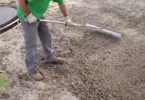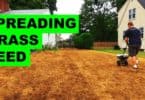The cost of fencing a yard varies greatly, even if the yards being fenced are located in the same area. This is due to the many factors that influence the price of the fencing project. Property location, size and shape of yard, type and quality of materials, type of tools utilized, as well as types of permits and labor all affect the price tag. However, the overall average cost for fencing a 5,500 sq. ft. urban yard is $1,500 if done as a DIY project. The same fence will cost approximately $2,500 to $3,000 if someone else does the work.
Contents
Property location, permits and building codes
The property’s location will determine what permits are required and what fencing materials are readily available. For instance, building permits, which range from $25 to $300, are likely to be required more frequently in urban areas than they are in rural areas. Electric fences and barbwire fencing materials will be easier to obtain in rural areas than in metropolitan areas. And importing materials will be more costly than purchasing locally produced materials. For instance, a person in Ridgecrest, California may pay two to three times as much as a person in Big Cedar, Oklahoma when purchasing cedar boards. The location also determines which types of stores are available for purchasing the materials. Buying materials at a “big box” store such as Lowes or Home Depot is cheaper than purchasing the same materials at a specialty store such as the Fence Store. However, specialty stores frequently offer a wider selection of materials than big box stores do.
The property’s location also determines which building codes are enforced. The building codes greatly influence the type and quality of materials that are used. For example, building codes in California may require the fence be built to withstand earthquakes while in Michigan the requirement may be for the fence to withstand the weight of a heavy snowfall. If the homeowner belongs to a housing association, then there may be additional restrictions upon the type and quality of materials used. The cost of labor and availability of a skilled labor force is also partly determined by the yard’s location. For instance, it will be less expensive and much easier to hire skilled general laborers in areas with high unemployment rates than it is in areas with lower unemployment rates.
Size and shape of yard
It stands to reason that the size of the yard will greatly affect the outlay for the fencing. Typically, fencing materials are purchased by the linear foot. The average price is $4-$5 per linear foot, whether it is chain link or wooden boards. Therefore, it is much more expensive to fence in a large area than it is to fence in a very small area. Oddly shaped yards are slightly more expensive to fence than standard shaped yards due to the increased complexity of the design and level of labor skills required. Occasionally, the soil’s composition may also factor into the price. If there is a huge amount of rock to dig through, the fencing company may charge extra for the labor.
Type and quality of materials
However, several things besides just the landowner’s personal preferences must be considered when selecting supplies. The homeowner must determine which fencing will provide the highest return on investment immediately as well as in the future. This includes thinking about how the fence may affect relationships with neighbors, home security, property value, safety, health, environmental impact and insurance premiums. Therefore, the homeowner must carefully reflect upon the primary purpose of the fence when choosing the type and quality of the materials.
Fences can serve a wide variety of purposes. They can provide privacy, home security, property décor and add value to a home. Fences can also set safe boundaries for pets and children, as well as mark property boundary lines. Fences can also be utilized as part of a soundproofing or air filtration system, as a trellis for tall plants or to provide shade. So sometimes, it is better to spend a little extra money on higher quality materials and/or professional help. This provides better assurance that the fence will meet the local building codes and can withstand the local environment. At other times, it may not be worth the extra cost to install a high-dollar fence when a less expensive fence would do just as well.
Types of tools, equipment and labor
It also stands to reason that the types of tools, equipment and labor that are used will have a major impact on the overall cost of fencing a yard. Fencing projects are seldom a one-person job, no matter which type of fence is chosen. Therefore, the homeowner should plan on paying hired help or rewarding volunteer workers. If the homeowner does the fencing as a DIY project, he or she may have to rent or purchase certain tools, such as a post-hole digger. The DIYer may also need a power screw gun or an air nail gun and air compressor. The types of tools used will vary according to whether it is an electric, wooden, metal or plastic vinyl fence. The cost of labor will also vary due to type of fencing installed. This is due to the fact that some materials are more difficult to work with because the material lacks innate flexibility or may be bulkier.
Getting an estimate
The best way to determine the actual cost of fencing a yard is to get an estimate from the various local fencing contractors. Most licensed, professional contractors will provide a free consultation and estimate without any obligations to the landowner. DIYers may obtain an estimate by visiting a Lowe’s, Home Depot or Sutherlands or some local home improvement store. Just tell the sales associate the size of the yard, the type of fence, how many gates and any other pertinent details. The clerk will then figure out the approximate cost of the materials. The homeowner can obtain an approximate cost for the permits by contacting the agency in charge of issuing the building permits. And the DIYer can also figure out the cost of rewarding any helpers by estimating how much time and labor will be involved. Usually, it takes about half a day to fence in a small area with two people working, assuming at least one person is an experienced fence installer. Once the homeowner has obtained the estimates for materials, labor, and permits, then he or she just has to combine them to get the overall cost of the project.
<>







